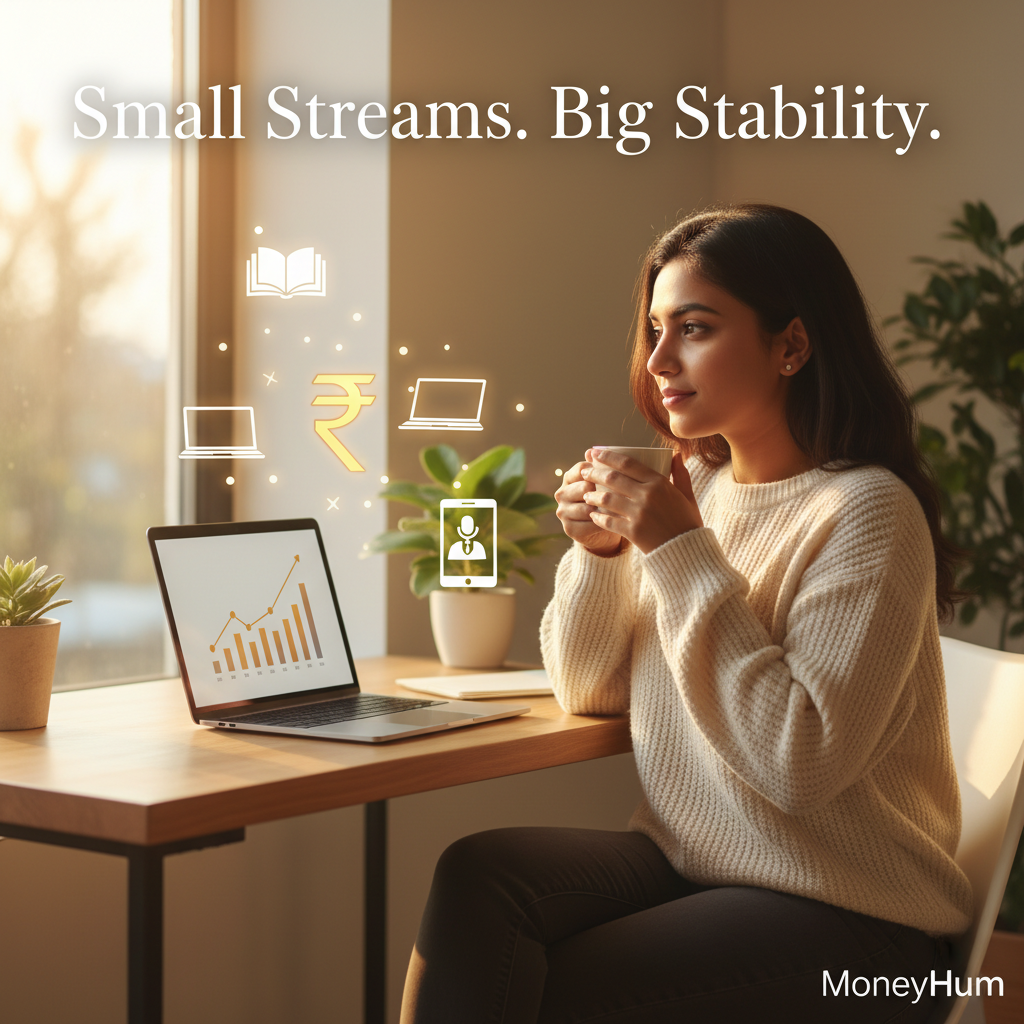Part 1: The Psychology of Side Income: Beyond the Money
It starts quietly.
Not with ambition, but with unease.
You check your balance on a Thursday evening. The salary came just two weeks ago, and yet, the numbers already look thinner than they should. Rent, EMIs, small online orders, groceries that somehow cost more every month. You are not irresponsible, you are just human, living in a time where “enough” keeps shifting.
And then comes that thought, maybe I should start something on the side.
A way to earn a little extra, maybe ₹5,000 a month. Nothing dramatic. Just enough to stop worrying about the next bill, or to finally start saving for something that feels like the future.
That thought is not greed.
It is the quiet whisper of self preservation.
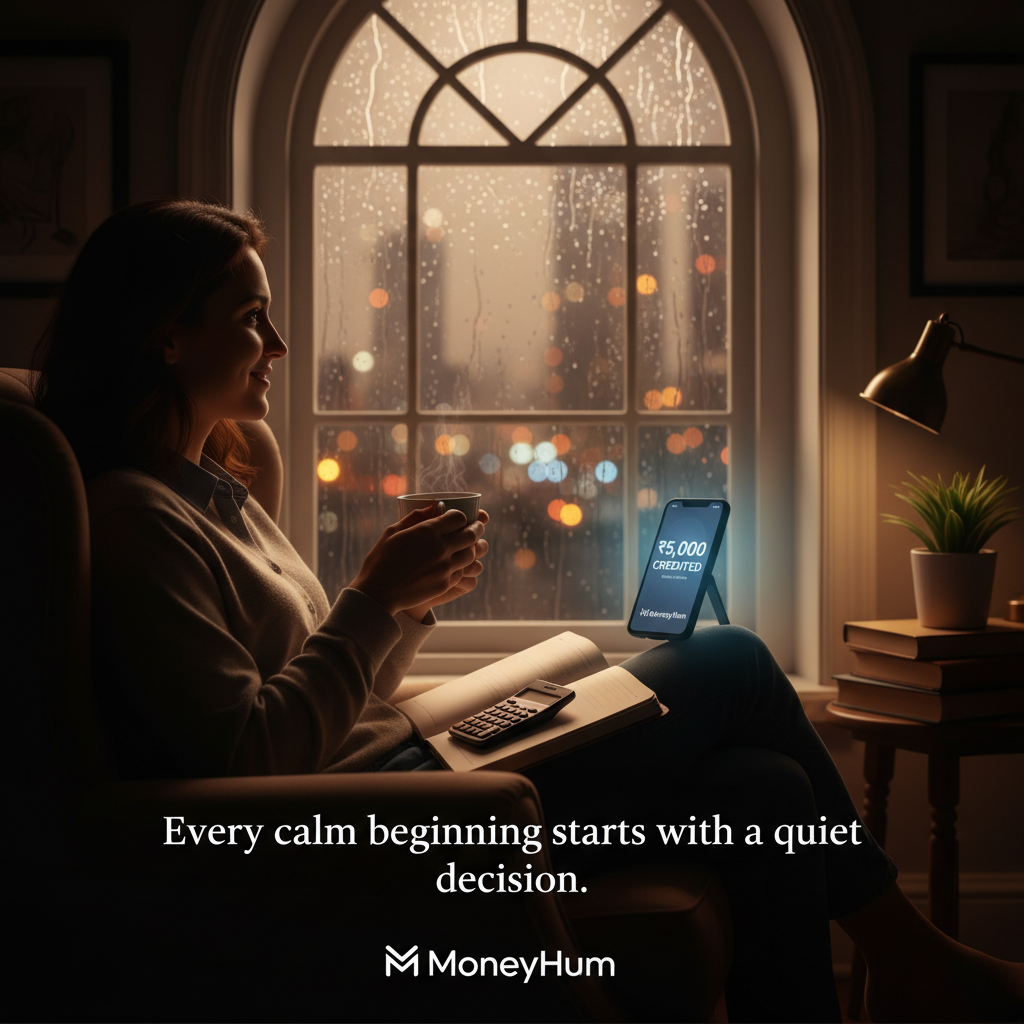
The Emotional Side of Earning: Finding Financial Breathing Room
Most people do not begin their side income journey chasing riches. They begin because they want breathing room.
When life feels tight, financially or emotionally, money becomes more than math; it becomes a measure of safety. Behavioral psychologists often call this the “security drive.” It is our deep, ancient instinct to build a cushion against uncertainty. Back in tribal times, it was food storage. Today, it is emergency savings and side hustles.
The modern version of that instinct is subtle. It shows up when you say,
“If I could just earn ₹5,000 more each month, I would feel less anxious.”
That sentence is not about the money itself, it is about relief.
A side income is not just about multiplying cash flow; it is about restoring a sense of control in an unpredictable world. When you earn something on your own terms, even if it is small, you regain a quiet confidence that your livelihood does not depend entirely on a single source.
If you have ever felt that low hum of financial tension, the kind that never really goes away, know this: you are not broken, lazy, or late. You are living through a system that constantly stretches expectations faster than incomes.
And that is why this movement toward multiple income streams is not a trend. It is an emotional evolution.
Overcoming Financial Fragility and Single-Income Dependence
For decades, we were taught to follow a simple formula:
Study well → Get a stable job → Live comfortably.
That story worked when inflation was tame, housing was affordable, and one salary covered three people’s needs. But today, it is not uncommon for even dual income families to feel financially fragile.
This fragility creates what psychologists call “chronic financial anxiety” a low level background stress that subtly shapes behavior.
It is why:
- You might hesitate before opening your banking app.
- You might feel guilt after spending on something nice.
- You might worry about “what ifs” that never used to cross your mind.
That anxiety does not mean you are doing something wrong. It means you are human, living in a system that asks for more flexibility than one paycheck allows.
You can explore this deeper in
👉 Financial Anxiety Is the Modern Disease: How to Heal Money Fear & Stress
which breaks down the psychological toll of financial uncertainty, and how calm clarity can become a form of strength.
Side Income as Diversification: Employee to Creator Identity Shift
When people talk about “side hustles,” the conversation often slips into productivity theater: work more, sleep less, grind harder.
But in truth, a side income does not have to mean hustle at all. It can simply mean diversification of security.
Think of it like an emotional SIP (Systematic Investment Plan).
Each small effort, an online skill, a weekend gig, a digital product, adds a drop to your reservoir of self reliance. Over time, that emotional compounding creates not just financial safety but psychological steadiness.
When you earn even ₹1 outside your main job, something subtle happens inside you:
your identity shifts from employee to creator.
From dependent to capable.
That is the real value of side income, it teaches you that you are not powerless in the face of uncertainty.
H3: Humanizing ₹5,000: The Power of the Earned Control Bias
Let us humanize the number.
₹5,000 is a dinner out for some, but for many, it is a full grocery cycle, a child’s school expense, or the start of a SIP. More importantly, it is a psychological milestone.
Why?
Because once you see ₹5,000 come in from something you created, it changes your internal equation with money.
Suddenly, money is no longer this distant, opaque system that happens to you every 30 days, it is something you can influence.
Behavioral economists call this “earned control bias.” It is when people feel calmer and more satisfied when their actions visibly produce results, even if the result is small.
It is the same reason why homegrown vegetables taste better, or why a handcrafted desk feels different than a store bought one. The value is amplified by ownership.
A side income, then, is not just a financial tool; it is an emotional mirror.
It reflects your ability to create, to adapt, and to grow.
The Calm Approach: Side Income Without Hustle Culture Burnout
Here is an important truth that rarely gets spoken aloud:
You do not have to burn out to build more.
The “hustle” narrative, work 16 hours, sleep 4, monetize every minute, is not sustainable. It promises freedom but often delivers exhaustion. What people truly seek is not busyness, it is agency.
The calm approach to side income starts with redefining its purpose. It is not an escape from your main job, it is an extension of your identity.
You can start small.
You can move slow.
You can choose something that aligns with your energy, not drains it.
If you have ever wondered whether it is okay to earn more without working harder,
read 👉 The Hidden Cost of Constant Hustle: Why Doing Less Earns More which explores how focus, rest, and alignment actually increase both productivity and peace.
2025 Side Income Turning Point: Technology, AI, and Stability
Something profound is happening in 2025.
Technology has democratized income creation.
AI tools, marketplaces, and content platforms have reduced barriers once reserved for the technically gifted. You no longer need to be an expert programmer to sell a course, or a financial analyst to create a small investing blog.
More importantly, there is a collective emotional shift, people no longer just want success. They want stability with sanity.
That is why this guide is not just a list of “side hustle ideas.” It is an emotional and mathematical roadmap to building small, consistent, meaningful sources of extra income, the kind that support your peace of mind as much as your wallet.
In the next part, we will step deeper into why people start side incomes, and why so many give up halfway.
We will explore the hidden psychology of earning, from fear of failure to comparison traps, and how to overcome them with calm clarity.
🪞 Reflection Exercise (Optional but Transformative)
Before moving to Part 2, take a quiet moment tonight and ask yourself:
“If I earned ₹5,000 extra this month, what would that mean to me emotionally?”
Not what you would spend it on, but what it would feel like.
Freedom? Relief? Security? Pride?
Your answer will reveal your real reason for wanting a side income, and once you name it, you will know exactly how to build around it.
Part 2: Hidden Psychology of Side Hustles: Control, Fear, and Consistency
There is a moment in everyone’s financial life that does not show up on statements.
It is the moment you realize:
“I am working so hard, but I still feel… trapped.”
Not broke. Not desperate. Just trapped, inside a structure where money enters and leaves with no sense of control. That quiet unease becomes the seed of your desire for something more.
For most people, that “something” is not wealth, it is freedom.
Freedom to choose. To say “no.” To breathe.
But before that freedom grows, there is a storm to understand, the invisible psychological patterns that shape how we start, stop, and sometimes sabotage our side income journeys.
Overcoming the Control Fallacy in Your Side Income Journey
When we start exploring side income ideas, there is a burst of energy. You imagine yourself freelancing, teaching, creating, finally taking charge of your income.
It feels empowering… until reality slows you down.
A week passes. Two. You face friction, unclear clients, delayed payments, less time than you expected. Suddenly, the very freedom you craved begins to feel like another job.
You think, “Maybe I am not cut out for this.”
That thought, though, is not failure. It is the illusion of control breaking down.
Behavioral psychology calls this “Control Fallacy” our tendency to believe that freedom means total ease. But real freedom always carries structure. The idea of “do what you love and money will follow” often hides the truth: money follows systems, not just passion.
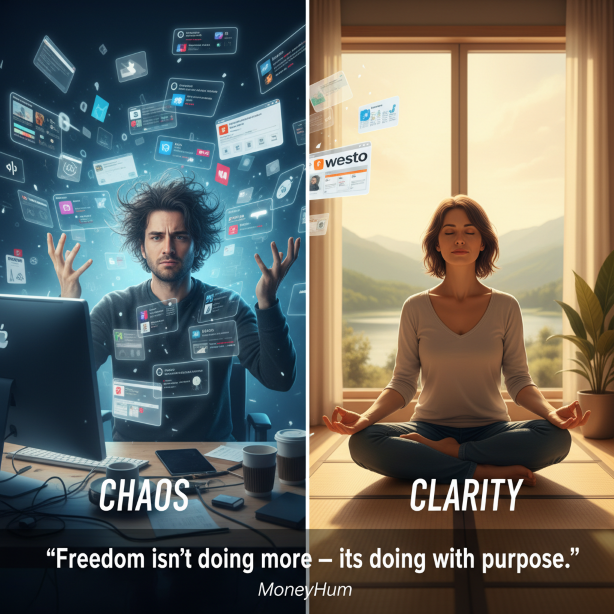
To stay calm in this phase, you have to replace excitement with rhythm, slow, repeatable effort that compounds quietly.
This is where emotional consistency begins to outperform bursts of motivation.
The Psychological Trap of Loss Aversion and Starting Small
One of the most common emotional blocks in building a side income is the belief that “small is not worth it.”
We tell ourselves:
“What is ₹2,000 or ₹5,000 going to change?”
“If it is not big, why even start?”
But this is one of money’s deepest psychological traps loss aversion and status comparison.
Loss aversion makes small gains feel insignificant compared to potential “big” ones.
Status comparison makes effort feel meaningless unless it is impressive to others.
Together, they form a kind of quiet paralysis. You do not start not because it is hard, but because it feels too small to be worth starting.
But small beginnings are not weakness; they are calibration.
Every financially independent person you admire started with a tiny source of confidence that multiplied over time.
Consider this:
If you start a ₹5,000/month side income this year and grow it by just ₹2,000 per year, in 4 years you are earning ₹11,000/month, over ₹1.3 lakh a year. That is not magic; it is arithmetic. Yet, the deeper transformation is not in your wallet, it is in your mind.
You have rewired your relationship with effort, time, and possibility.
How to Beat the Social Comparison Bias and Find Your Side Income Rhythm
There is another emotional undertow most people never talk about: social comparison bias.
You see someone on Instagram earning ₹50,000 from freelancing. Another person “made ₹1 lakh selling eBooks.” Suddenly your ₹3,000 milestone feels trivial.
And with that one emotion, envy, the journey loses its joy.
Psychologists like Leon Festinger described this decades ago: our self worth often comes from relative progress, not real progress.
But the truth is: side income is not a race; it is a rhythm.
The point is not how much others earn. It is whether you can sustain a peaceful, parallel stream of income without draining your energy or joy.
When you stop comparing speed and start observing alignment, you naturally choose side incomes that fit your life, not fight it. You choose what is sustainable over what looks successful.
That is how you quietly win in the long run.
Dealing with Impostor Syndrome in Independent Earning
Here is a feeling that often surprises first time side earners:
Even when the money comes in, they feel unworthy of it.
You might think, “I just did this part time; do I really deserve this?”
Or, “Who am I to charge for this skill?”
This is classic impostor syndrome, the emotional residue of years spent equating effort with legitimacy.
In traditional jobs, money feels earned because it is attached to structure: hours, hierarchy, appraisal. But when you earn independently, that structure disappears. You are both the creator and the validator, and that is deeply unfamiliar territory.
The key is to remember: effort does not always have to feel heavy to be valuable.
Ease can also be earned.
This shift, from self doubt to self recognition, is where emotional maturity meets financial maturity. You learn that the money you make peacefully is no less real than the money you make through stress.
Breaking the Dopamine Dependency and Control–Chaos Cycle
If you have tried multiple side projects before and quit halfway, you might notice this emotional cycle:
- Excitement: You discover a new idea and dive in.
- Effort: You put time in, maybe even earn a little.
- Doubt: Results slow down; frustration sets in.
- Abandon: You move to the next shiny thing.
- Repeat: A new “opportunity” appears, and the loop restarts.
This pattern is not laziness, it is dopamine dependency.
Our brains crave novelty more than progress. When progress slows, the brain interprets it as failure, and we search for another “high.”
The only way out is through structure, small, consistent actions that do not depend on motivation.
This is the same principle that makes SIPs work: you invest quietly, without emotional drama, and let time multiply the outcome.
That is why a calm, consistent side income approach mirrors long term investing more than hustling. Both rely on boring persistence.
You can read more about this principle in
👉 The Path to Real Wealth: Why Patience and Compounding Beat Shortcuts
Building Emotional Safety Nets for Confidence and Consistency
When you are starting something new, be it freelance writing, a YouTube channel, or small reselling, you need more than skills; you need emotional safety nets.
Here is how to build them:
🧩 1. Start privately.
Do not announce your plans. Build silently until you see traction. Public validation is nice, but early stage pressure can kill creativity.
🧩 2. Measure effort, not outcomes.
If you wrote 10 posts, made 3 calls, or learned a tool, you have won for the week. Income will follow consistency.
🧩 3. Keep the goal emotional, not numerical.
The first milestone is not ₹5,000, it is peace of mind. Once your effort starts reducing anxiety instead of adding to it, you are moving right.
🧩 4. Accept the plateau.
Some months will feel slow, maybe even pointless. But remember: even the months that do not earn money build capacity.
Growth, like compounding, happens invisibly before it becomes visible.
The Ultimate Goal: Defining Financial Freedom and Breathing Room
Freedom is not doing anything.
Freedom is not needing to do everything.
When your income sources multiply, your dependency on one system, one boss, one paycheck, begins to dissolve. That space between obligation and choice is where calm lives.
That is the ultimate goal of a side income, not busyness, not riches, but breathing room.
When you start understanding money as an ally, not an enemy, the emotional turbulence starts to settle. You stop chasing intensity and start cultivating continuity.
🕊️ Gentle Reminder Before You Begin
You do not need a “perfect” idea to start.
You need permission, to experiment, to fail gently, to learn slowly, and to stay kind to yourself in the process.
Even if your first attempt earns ₹2,000, it is not “small.”
It is proof that your energy can convert into value, and value into freedom.
That is what this journey is about.
Not side income.
Side peace.
Part 3: The ₹5,000 to ₹20,000 Reality: Building Financial Stability
There is something deeply human about small beginnings.
We tend to underestimate them, a ₹5000 income feels “too small,” a ₹2000 gig feels “not worth the time.”
Yet, every financial system, from investing to entrepreneurship, is built on one quiet law:
Consistency beats magnitude.
₹5000 today is not about what it buys; it is about what it becomes.
The Compounding Power of Small Wins: Arithmetic and Patience
Let us begin with a clear eyed example.
Imagine you build a ₹5000/month side income in 2025.
It is modest, perhaps a weekend gig, freelance writing, tutoring, or digital micro work.
Now, instead of spending it, you put that ₹5000 into a SIP (Systematic Investment Plan) every month, earning around 10% annual returns.
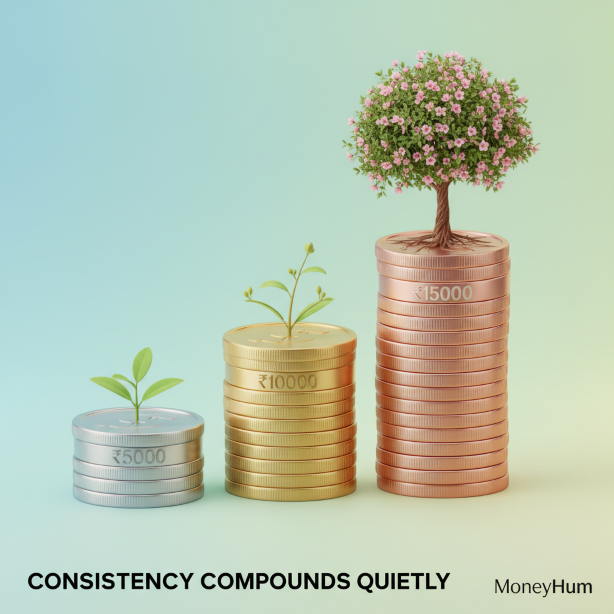
| Year | Monthly SIP (₹) | Annual Return (10%) | Value at Year-End (₹) |
|---|---|---|---|
| 1 | 5,000 | 10% | 63,000 |
| 3 | 5,000 | 10% | 2,00,000+ |
| 5 | 5,000 | 10% | 3,80,000+ |
| 10 | 5,000 | 10% | 10,00,000+ |
So what began as “just ₹5000” a weekend income, quietly becomes ₹10 lakh over a decade.
That is the power of patience, and it mirrors the psychology of compounding we explored in
👉 The Path to Real Wealth: Why Patience and Compounding Beat Shortcuts
The Side Income Equation: Time, Skill, Scalability, and Stress
There is a way to think about side income not as “extra work,” but as a formula for stability:
Side Income = (Available Time × Skill Use × Scalability) ÷ Stress
Let us decode this.
- Available Time: How many hours per week can you peacefully dedicate?
- Skill Use: Are you using something you already know, or learning from scratch?
- Scalability: Can this income grow without adding equal effort every time?
- Stress: The emotional cost. If it exhausts you, it is not sustainable.
When you multiply the first three and divide by the last, you find your “Side Income Sweet Spot.”
That is the zone where you earn consistently without emotional burnout.
This single equation changes everything, because it helps you earn in alignment with your life, not in conflict with it.
7 Realistic Side Income Archetypes for 2025 (Skill, Digital, Market, Local)
Each side income path falls into one of seven archetypes.
You do not need to try them all. You just need to find the one that matches your temperament and lifestyle.
Let us go through them, practically, gently, and with honest math.

1. The Skill Sharer
Time: Medium | Stress: Low | Scalable: Medium
You use your existing expertise to earn, teaching online, coaching, or freelancing in your skill area.
Examples:
- Tutoring students on platforms like UrbanPro or Teachmint.
- Freelance work on Fiverr or Upwork (writing, marketing, design).
- Offering English speaking or communication coaching.
Potential: ₹5000–₹20,000/month
Psychological Benefit: Builds confidence and identity based income.
Key Skill: Consistency. Clients trust reliability more than brilliance.
2. The Digital Builder
Time: High initially | Stress: Medium | Scalable: High
You create digital assets, YouTube videos, blogs, or affiliate content.
At first, it feels slow. But digital assets compound like investments.
Examples:
- Creating a small blog (like MoneyHum started) and monetizing with affiliate links.
- YouTube content on simple topics, tech reviews, finance explainers, productivity, music, or meditation.
- Selling eBooks or short guides.
Potential: ₹1000 in Month 3 → ₹15,000+ in Month 12
Psychological Benefit: Turns creativity into independence.
Key Skill: Patience. It is not instant, but it is infinite.
3. The Market Learner
Time: Medium | Stress: Medium High | Scalable: High
If you are drawn to finance, you can learn to grow wealth through disciplined investing, not speculation.
Examples:
- Monthly SIPs or mutual funds.
- Dividend paying stocks.
- Option writing or covered calls (for experienced investors).
- Building small model portfolios.
Potential: ₹5000–₹25,000/month (after capital maturity)
Psychological Benefit: Teaches emotional control and patience.
Key Skill: Risk management, not prediction.
👉 Build a Strong SIP Habit: Your Simple 12-Month Plan for Beginners can guide you here.
4. The Local Creator
Time: Flexible | Stress: Low | Scalable: Low
Offline, human based income, simple, fulfilling, and grounded.
Examples:
- Weekend baking, photography, music teaching.
- Renting out home equipment or parking.
- Organizing small workshops or craft stalls.
Potential: ₹3000–₹10,000/month
Psychological Benefit: Adds meaning and community connection.
Key Skill: Authenticity, people buy you, not just what you sell.
5. The Reseller or Curator
Time: Medium | Stress: Medium | Scalable: Medium
You do not create, you curate. You find, source, or resell products online.
Examples:
- Selling thrifted or crafted items on Instagram, Etsy, or Meesho.
- Reselling niche products (stationery, skincare, gadgets).
- Flip local deals through OLX or Facebook Marketplace.
Potential: ₹5000–₹15,000/month
Psychological Benefit: Builds negotiation and marketing instincts.
Key Skill: Eye for demand, and gentle persistence.
6. The Automator
Time: High upfront | Stress: Low after setup | Scalable: High
You build something once, and let it run with minimal maintenance.
Examples:
- Creating an AI tool or productivity app.
- Building Notion templates or automations.
- Writing short digital playbooks.
Potential: ₹10,000–₹50,000/month (after setup)
Psychological Benefit: Teaches leverage, time becomes an ally.
Key Skill: Design thinking and calm iteration.
7. The Hybrid Human
Time: Adaptive | Stress: Medium | Scalable: Balanced
This is the future model, blending your professional skill with digital leverage.
Examples:
- An HR professional offering interview prep online.
- A trader sharing educational content on markets.
- A marketer consulting small startups part time.
Potential: ₹10,000–₹40,000/month
Psychological Benefit: Expands your professional identity.
Key Skill: Positioning, knowing what you are uniquely good at.
The 3-Tier Side Income Strategy: Stability, Growth, and Creativity
To build stability instead of chaos, design your income layers like a financial pyramid.
Tier 1 — Stable Layer (Foundational)
Goal: Reliability
Freelancing, part time teaching, SIP investing, income that arrives predictably.
Even ₹3000/month here builds emotional safety.
Tier 2 — Growth Layer
Goal: Scalability
YouTube, affiliate marketing, reselling, slower growth, higher future value.
Time heavy at first, light later.
Tier 3 — Creative Layer
Goal: Expression + Long-term payoff
Your ideas, digital products, or tech tools. These are your “lotus projects” quiet seeds that bloom later.
Even if they do not pay immediately, they build your personal ecosystem.
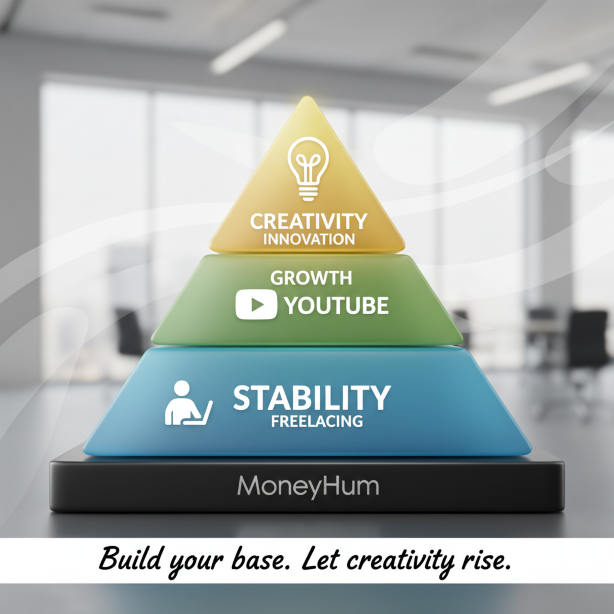
Designing Your “Peace Portfolio”: Focus Capital and Emotional Budgeting
Here is how to build a calm, effective income ecosystem:
| Step | Focus | Example |
|---|---|---|
| 1 | Identify your Energy Window | 2 hours nightly or 4 hours weekend |
| 2 | Choose 1 project in Tier 1 | Tutoring / Freelancing |
| 3 | Choose 1 slow compounding project in Tier 2 | YouTube / Blog |
| 4 | Automate 20% reinvestment | SIP / Skill course |
| 5 | Reflect every 3 months | What feels light, what feels forced |
This is not just time management, it is emotional budgeting.
You are allocating your focus capital wisely.
The Financial and Emotional Compounding of Calm
Let us quantify how peace compounds, too.
| Month | Side Income (₹) | Saved/Reinvested (₹) | Emotional Effect |
|---|---|---|---|
| 1 | 2000 | 1000 | “I can do this.” |
| 3 | 5000 | 2500 | Relief. “I am building something.” |
| 6 | 8000 | 4000 | Pride. “I am in control.” |
| 12 | 12,000 | 6000 | Calm. “Money listens to me now.” |
The calm does not come from the number, it comes from the rhythm.
The Real Side Income Reward: Financial Stability and Choice
If you reach ₹10,000/month in side income by next year, it is not just ₹1.2 lakh/year.
It is:
- Freedom from small financial panic.
- Flexibility to explore better jobs.
- Funding for future investments.
- Emotional safety to say “no” when needed.
You do not have to chase ₹1 lakh/month.
You just have to reclaim your freedom margin.
That is what small, steady side incomes really buy, the quiet luxury of choice.
Part 4: From Extra Income to Financial Ecosystem: Quiet Growth
There is a moment in every consistent earner’s journey when the side income stops feeling like “extra.”
It begins to feel like oxygen, quiet, consistent, always there.
That shift does not happen when you earn more.
It happens when your effort starts creating systems that work quietly even when you rest.
Because the truth is:
A stable financial life is not about how much you earn.
It is about how much of your earning system runs without anxiety.
Moving from Hustle to Harmony: Pace, Purpose, and Patience
Most people treat side income like a sprint. They pour in energy, burn out, and retreat, thinking they “failed.”
But sustainable side income is more like a garden. You do not dig faster to grow faster. You plant, water, and let time compound quietly.
That is why at MoneyHum, we call it “Quiet Growth.”
A philosophy where money is not chased but cultivated, at your own rhythm.
Let us use a simple framework to make this shift happen:
Pace. Purpose. Patience.

Designing a Sustainable Pace: Energy Windows and Micro-Commitments
The most underestimated factor in side income success is energy management.
People do not fail because of lack of opportunity; they fail because of emotional exhaustion.
✦ Find Your Energy Window
Ask yourself:
“When do I feel most calm, creative, or clear?”
For some, it is late night. For others, early morning.
That is your energy window, the 90 minute block where you can build without resentment.
If you can devote just 6 hours a week to your side work, two 2 hour sessions + two 1 hour micro sessions, you can create momentum without burnout.
✦ Avoid the “Monday Myth”
Many delay side work until they “feel ready.” But readiness rarely arrives.
Instead, create micro commitments:
- 30 minutes to brainstorm ideas.
- 1 hour to draft or design something.
- 10 minutes to analyze income numbers.
You do not need marathon sessions; you need continuity.
This aligns beautifully with the rhythm of SIP investing, calm, recurring, predictable.
👉 Build a Strong SIP Habit: Your Simple 12-Month Plan for Beginners explains how that discipline transfers from money to mindset.
The Anchor of Purpose: Alignment with Temperament and Values
Side incomes that last are born not from greed but from alignment.
When your income stream reflects your values, it sustains you emotionally even in slow months.
Ask yourself three reflective questions:
🪞1. What emotion do I want my side income to bring?
Peace? Pride? Security? Recognition?
Your answer defines your direction.
🪞2. What do I naturally enjoy teaching, sharing, or creating?
If you like explaining, teaching will suit you.
If you like exploring, content creation will.
If you like organizing, reselling or curation fits.
Purpose does not start with the market, it starts with temperament.
🪞3. What problem do I feel emotionally connected to solving?
If your work touches a real need (not just a trend), it endures longer.
For example:
- A teacher who loves helping students overcome fear of English.
- A trader who wants to demystify markets for beginners.
- A creator who wants to bring calm into chaotic digital lives.
That emotional anchor turns short term gigs into long term legacies.
Patience and Delayed Gratification: The 90-Day Reality Window
Patience is not just waiting.
It is the art of continuing without visible reward.
In behavioral finance, this is called “delayed gratification tolerance.”
It is the single biggest predictor of long term success, in money, fitness, and even relationships.
✦ The 90-Day Reality Window
Most side income projects show minimal visible reward for the first 90 days.
That is where 90% of people quit.
The calm earners do not. They observe.
They adjust slowly, they measure softly, and they let effort mature like interest.
You can use a simple 3 month cycle for everything you do:
| Month | Focus | Example |
|---|---|---|
| 1 | Foundation | Learn, experiment, setup system |
| 2 | Refinement | Remove what drains, improve what flows |
| 3 | Stabilization | Automate, measure, scale gently |
Then, repeat the cycle.
Every loop adds smoothness and scale.
The Personal Income Ecosystem Model: Create, Capture, and Compound Value
Once your effort stabilizes, the next step is to build your personal income ecosystem.
Think of it as three connected loops:
- Create Value → You produce something small but real (skill, content, service).
- Capture Value → You find channels that reward it (clients, affiliate systems, digital products).
- Compound Value → You reinvest the income into better tools, learning, or automation.
Repeat this loop quietly, and your “side” income becomes an ecosystem that keeps running, even if you pause.
This is how real creators, consultants, and educators thrive today, not through aggression, but through ecosystem thinking.
👉 Your Financial System Needs a Dashboard — Not Just Dreams
beautifully explains how this kind of system brings calm visibility to your growth, replacing emotional chaos with data driven clarity.
Strategic Reinvestment: Skill, Systems, and Assets
Once you reach ₹10,000–₹20,000/month, you will face a new question:
“What do I do with this extra money?”
The answer defines your next phase of growth.
Option A — Reinvest in Skill
Buy better equipment, courses, or AI tools to improve quality and efficiency.
This compounds your capability.
Option B — Reinvest in Systems
Automate workflows, scheduling, payments, templates.
This compounds your time.
Option C — Reinvest in Assets
Convert a part of your earnings into SIPs, stocks, or emergency funds.
This compounds your peace.
That way, every rupee you earn begins working for you, not against you.
Emotional and Practical Scaling: Systems Over Goals
Scaling does not always mean “doing more.”
It often means “doing better, with less friction.”
Here is how to grow emotionally and practically at once:
| Emotionally | Practically |
|---|---|
| Stop chasing perfection | Start posting imperfectly |
| Replace “goals” with “systems” | Use weekly process checklists |
| Seek balance, not buzz | Schedule rest as rigorously as work |
| Use gratitude as growth fuel | Reflect monthly on “wins,” not gaps |
This way, growth feels grounded, not rushed.
Your side income becomes part of your life rhythm, not a rebellion against it.
The Freedom Margin Principle: Psychological Space and Choice
The goal of earning ₹5,000–₹20,000/month is not just financial. It is psychological.
It creates your Freedom Margin the gap between what life demands and what you can provide calmly.
When that gap widens, three things happen:
- You stop making desperate choices.
- You negotiate better, in jobs, relationships, and business.
- You start living from intention, not insecurity.
That is the real wealth side income brings, space to breathe.
✨ A Quick Reflection Exercise
Tonight, before sleeping, ask yourself:
“If my side income could fund one dream, not a bill, not a responsibility, but a dream, what would it be?”
Write it down.
That is your compass. Every rupee you earn on the side now has a story, not just a number.
Part 5: Quiet Growth: Redefining What “Extra” Income Really Means

It is late.
Your laptop is closed.
The day’s noise has softened into a low hum outside your window.
For a moment, you look at your phone, a few messages, a few updates, but what catches your eye is that small notification:
“₹5,000 credited to your account.”
A few months ago, that number would not have meant much. But tonight, it feels different.
Because this time, it did not come from your main job. It came from you.
Not from your boss.
Not from your schedule.
But from your quiet consistency.
And suddenly, ₹5,000 is not just money.
It is proof, that your time, your thoughts, your ideas can create value.
That your peace is not just something to hope for, but something you can build.
The Emotional Meaning of “Extra”: Learned Autonomy and Flexibility
When we talk about side income, most people imagine money as addition something on top of what they already earn.
But the real “extra” is internal. It is the extra calm, extra confidence, extra control that begins to take root once you realize that your financial stability no longer depends on a single source.
This is what behavioral psychologists call “learned autonomy” the feeling of freedom that comes when your effort translates directly into outcome.
That autonomy is quietly revolutionary.
For years, many of us were trained to think that peace comes from job security.
But the truth is, peace comes from income flexibility.
It is not how big your paycheck is.
It is how independent your peace is.
Measuring Emotional ROI: Relief, Confidence, and Control
Let us look at what that “side ₹10,000/month” really returns, not in rupees, but in emotions.
| Emotional Return | Description |
|---|---|
| Relief | You no longer feel tight between pay cycles. You exhale deeper. |
| Confidence | You feel capable, not just because you earn more, but because you can create more. |
| Control | You stop reacting to financial problems. You start anticipating them. |
| Joy | You experience money as creation, not just transaction. |
| Calm | You finally start to trust time, and yourself. |
This is the compounding of calm, the kind that changes not just your finances, but your relationship with uncertainty.
👉 To understand this deeper, revisit
How to Measure Real Progress in Life (When Money Isn’t Enough) it is a reminder that real wealth is measured in inner stillness, not outer numbers.
Defining “Defined Enough” and Aligning Earnings with Emotional Needs
Here is something worth remembering:
You do not need infinite income to feel free.
You need defined enough.
That is the difference between chasing and creating.
When you define what “enough” means, whether it is an emergency cushion, a small dream fund, or a monthly breathing margin, you stop living in comparison and start living in clarity.
The people who feel richest are not those who earn the most.
They are the ones whose earnings align with their emotional needs.
So before you chase another side project, ask:
“What am I actually trying to feel more of?”
Security? Pride? Freedom? Recognition?
That answer will show you where your real wealth lies.
The Ripple Effect: Options, Risk Tolerance, and Internal Dialogue
A ₹10,000/month side income seems small until you see its ripple.
Over time, it quietly shifts your life trajectory:
✦ It creates options.
You can save, invest, take a short sabbatical, or pivot careers.
✦ It changes your relationship with risk.
You start viewing risks as experiments, not threats.
✦ It changes your internal dialogue.
From “Can I afford this?” → “How can I design this?”
That is not just financial growth. That is psychological liberation.
From Earning Money to Making Yourself: Skill, System, and Emotional Intelligence
There is a subtle transformation that happens to everyone who builds a steady side income.
At first, you do it to make money.
Then, you realize you are actually making yourself.
Each time you earn from your own creation, you build three invisible assets:
- Skill Confidence → You realize you can learn and adapt anytime.
- System Thinking → You begin to view effort as structure, not chaos.
- Emotional Intelligence → You start relating to money with awareness, not anxiety.
These are the real compounding returns, invisible at first, undeniable later.
And this evolution, this inner shift, is what turns ordinary earners into calm creators.
Redefining Wealth: Financial Balance and Inner Stillness
The purpose of side income is not to escape your main work.
It is to expand your freedom inside it.
To have the space to say no to toxicity, yes to rest, and maybe to your next evolution.
Real wealth is not the noise of abundance, it is the quiet of balance.
It is the moment you realize you no longer check your phone in panic on the 29th of every month.
It is the quiet pride of knowing you have built your own safety net, thread by thread.
The Side Income Serenity Cycle: Create, Refine, Automate, Reinvest, Reflect
If you would like a simple, repeatable rhythm to sustain your growth, here is your “Side Income Serenity Cycle” the system behind emotional stability and financial calm.
| Step | Principle | Example |
|---|---|---|
| 1 | Create | Pick one income source aligned with your energy. |
| 2 | Refine | Improve slowly each month, remove friction. |
| 3 | Automate | Simplify payments, templates, tools. |
| 4 | Reinvest | Use part of earnings for SIPs or upgrades. |
| 5 | Reflect | Journal what you felt, not just what you earned. |
Repeat every quarter.
Growth will come, softly, sustainably, silently.
The Sound of Progress: Building a Relationship with Time
Progress does not always sound like noise.
Sometimes, it sounds like peace.
It is in the quiet of a weekend morning when you open your laptop not out of fear, but curiosity.
It is in the small ping of a new client email.
It is in that ₹5,000 transfer that tells you, you are growing, even when it is quiet.
So if you ever doubt yourself, if you think your side project is too small or too slow, remember this:
What you are building is not just an income stream.
You are building a relationship with time.
And in that relationship, every gentle action matters.
5 Calm Truths for Sustainable Side Income Growth
- Small is not weak. It is sustainable.
- Consistency beats speed. Always.
- Freedom grows quietly. Give it space.
- Your energy is capital. Spend it wisely.
- Peace pays the highest interest.
A Soft Web of Wisdom: Interlinked Reflections for Deeper Learning
When you are ready to go deeper, follow these gentle threads from this ecosystem:
- Heal your relationship with financial fear in 👉 Financial Anxiety Is the Modern Disease
- Rethink what real progress means beyond paychecks in 👉 How to Measure Real Progress in Life (When Money Isn’t Enough)
- Ground yourself in compounding patience with 👉 The Path to Real Wealth: Why Patience and Compounding Beat Shortcuts
- Build systems that hold your goals steady in 👉 Your Financial System Needs a Dashboard — Not Just Dreams
- Learn to earn with calm clarity through 👉 Build a Strong SIP Habit: Your Simple 12-Month Plan for Beginners
Together, these articles form a circle, not of financial advice, but of emotional evolution.
They remind you that money, at its core, is just energy, a reflection of what we give, learn, and grow into.
🌼 Closing Lines
So yes, 2025 does bring opportunities. AI tools, new markets, digital revolutions.
But the greatest opportunity is something quieter:
to earn without losing yourself.
Because in the end, the calmest wealth is not made by those who chase everything,
but by those who tend gently to something small, until it becomes enough.
If you have read this till the end, thank you❤️
With love,
Your Dearest Friend,
Chitraansh

